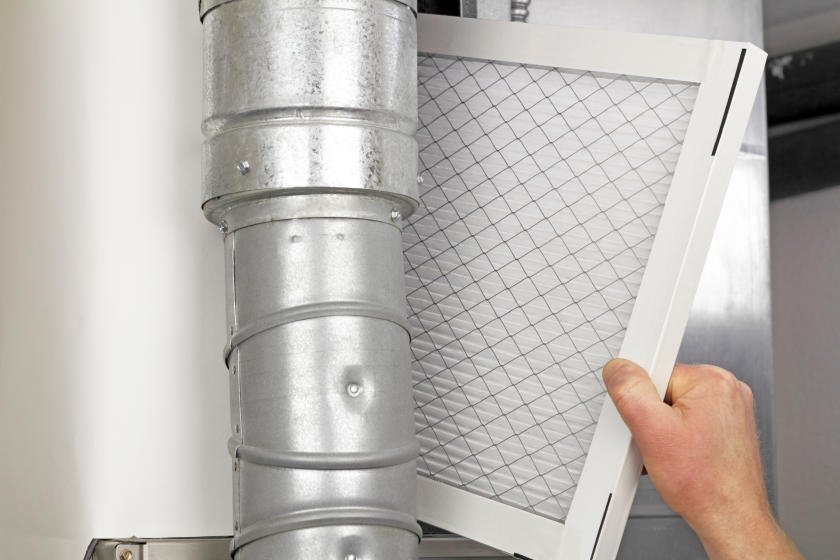Furnace filters help keep your HVAC system’s parts clean and running efficiently while also scrubbing the air that the system blows throughout your home. You can prolong the life of your heating and air conditioning components and breathe easy by periodically replacing your furnace filter. First, learn how to best choose the filter that’s right for you and your furnace.
Choose the Right-sized Filter
Check your furnace manual for the correct sized filter, or check the existing filter to determine dimensions. Most filters have the size prominently displayed on the surface in numerous places. You can also use a tape measure to determine size, if needed.
Helpful Tip
When you purchase a new filter, take your old filter with you or write down the dimensions needed so that you don’t forget them at the store.
Choose the Right Type of Filter
Determine what type of filter your HVAC system requires. Check your system’s manual for reference. Be sure to purchase filters rated for residential systems, rather than ones rated for commercial use (See more on this in the “Understand Filter MERV Ratings” section below). You want to find a furnace filter that removes the greatest number of contaminants and has the smallest effect on air flow for your HVAC system. There are a number of different types to choose from, ranging in style and type of material.
The most commonly used types of filters are disposables. These are usually made of layers of material such as fiberglass, cotton, polyester or paper, encased in a frame that slides into an opening into the ductwork. There are also adjustable filters and sizes for non-standard openings, and washable filters that can be removed and cleaned. Washable filters usually require more maintenance than other types of filters, and often don’t have the same level of efficacy as disposables. Electrostatic filters use static electricity to attract and trap small particles and come in either disposable or reusable models.
Generally, a filter’s performance level depends on the density of the material it’s made of and the size, type and amount of particles that attempt to pass through it. Over time (from a month to three months, usually), filters collect enough particles that their material becomes dirty and clogged and begins to lose efficacy. This is when you need to replace or clean your filter. A filter that becomes too dirty restricts air when passing through and can make your HVAC system work harder than it needs to, which is inefficient and causes faster wear and tear.
Different homes and occupants may need particular performance from HVAC filters. Homes with many residents, pets, smokers and those with severe allergies require higher-quality filters than others. Generally, though, it’s usually best to buy high-quality filters. While good ones may be a little more expensive, they will take out more pollen, dust and other irritating air particles than the cheaper filters. Consider using high-efficiency pleated air filters, which allow your furnace to pump cleaner air into your home, without undue strain on your furnace. The pleated design increases the filter’s surface area, capturing more lint, dust, pollen, mold and mildew. Pleated filters don’t need to be replaced as often as standard filters, but these filters should be replaced every three months compared to every month for economy filters.
Understand Filter MERV Ratings
A furnace filter’s Minimum Efficiency Reporting Value (MERV) is a measurement of how well it filters out particles in the air, how efficiently air flows through it and how long the filter should last. The MERV scale rates filters on a scale of 1 to 16. The higher the value, the more particles are removed. However, a high MERV rating doesn’t automatically mean a filter is better for your HVAC system. Most residential systems use filters with a MERV value of 1 to 12, generally, to remove the most particles but allow for efficient airflow. Filters with a MERV value any higher than 12 are usually used in commercial applications, such as laboratories and hospitals. Check your furnace manual to determine what the highest MERV-rated filter is that allows for maximum airflow in your system.
Here are some MERV ratings for the most commonly used types of filters:
- Disposable fiberglass – The most economical type of filter; they usually have a MERV rating of 2 or 3. These mostly just protect the furnace and keep it clean and don’t provide much in the way of air filtration.
- Washable filters – Washable filters have a MERV rating between 1 and 4. They also require frequent cleaning, and if not cleaned right, can circulate fungus and bacteria throughout the home.
- Disposable pleated – These commonly used filters usually have a MERV rating of anywhere from 6 to 12. A good, all-purpose choice for filtering the air that the furnace blows through your home.
- Electrostatic pleated – These filters are generally more effective than disposable pleated filters and are good for homes with pets or smokers, or those with extreme allergies because they filter out harmful and odorous particles. They usually have a MERV rating of around 8 to 12, whether they are disposable or reusable.
How to Replace Furnace Filters
Models vary, but there will be access panels that you must open or remove to get to your furnace’s filter (Keep a screwdriver handy — you may need to loosen screws to open a panel). Replace any disposable filters with new ones. If you have washable filters, remove them from the furnace and clean them with mild detergent, water and a sponge or cloth rag. Let them dry completely before putting them back in.
Alright! Now, you know how to best choose furnace filters for your home.
Project Shopping List
Here’s what you’ll need to complete this project successfully.












